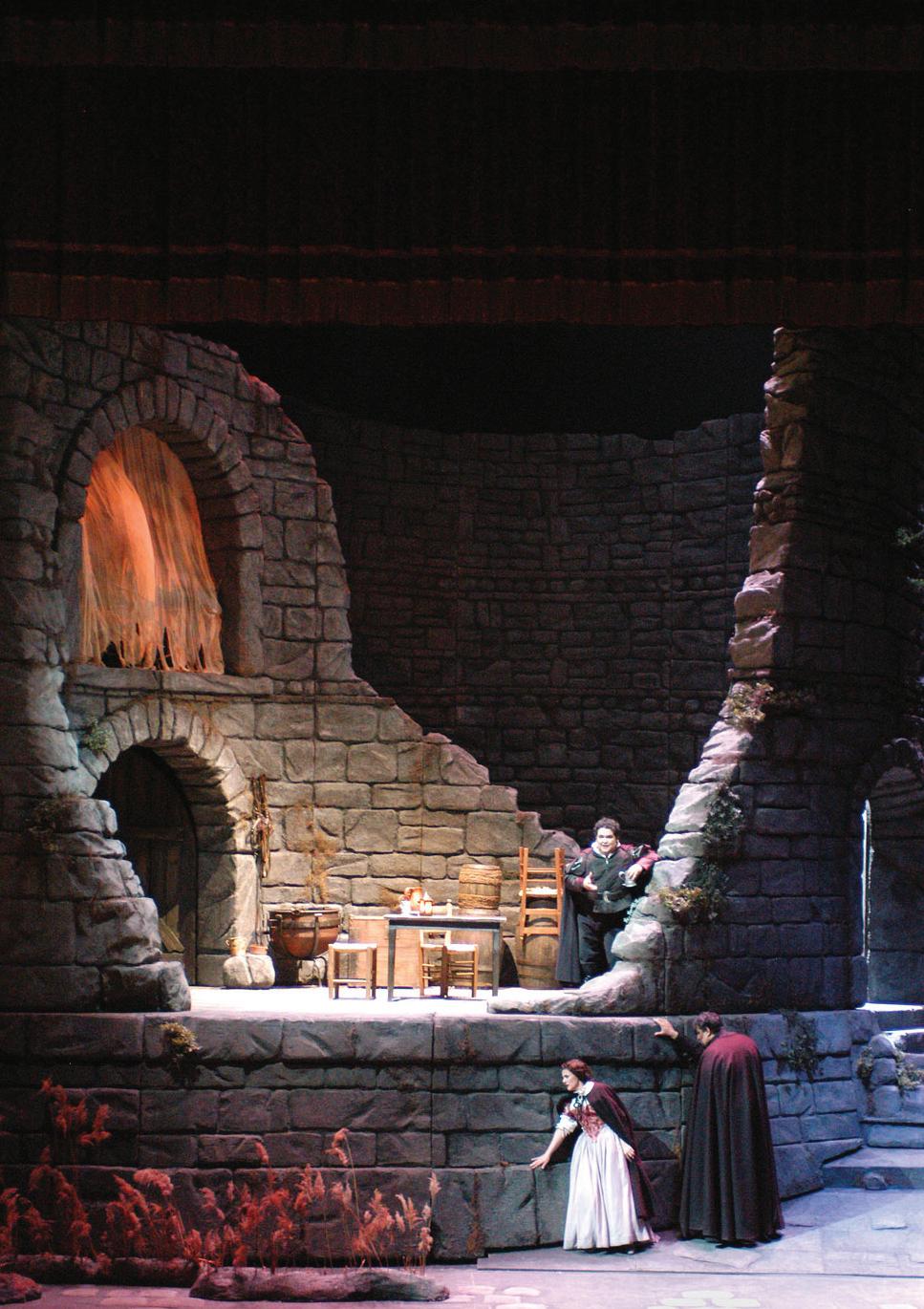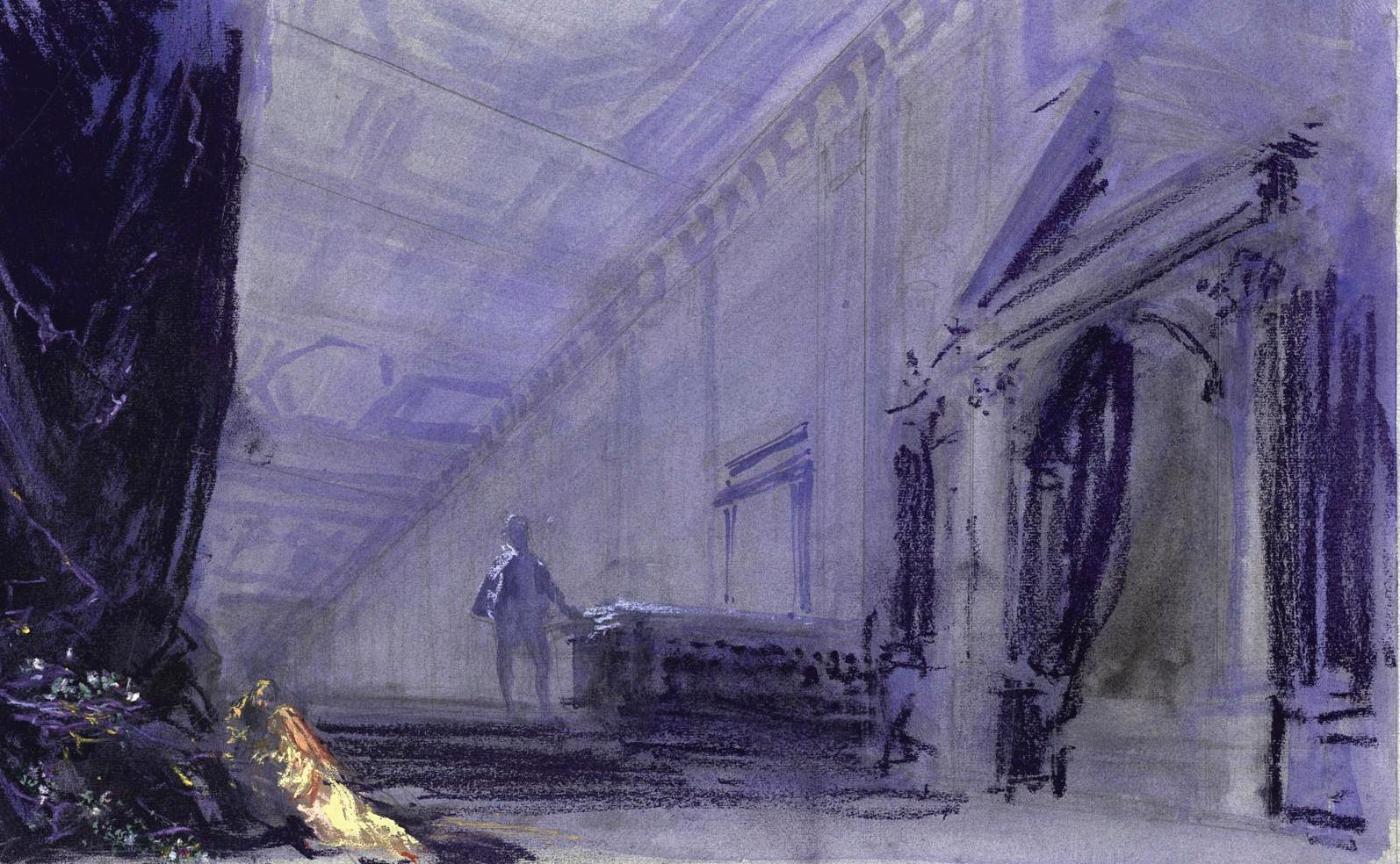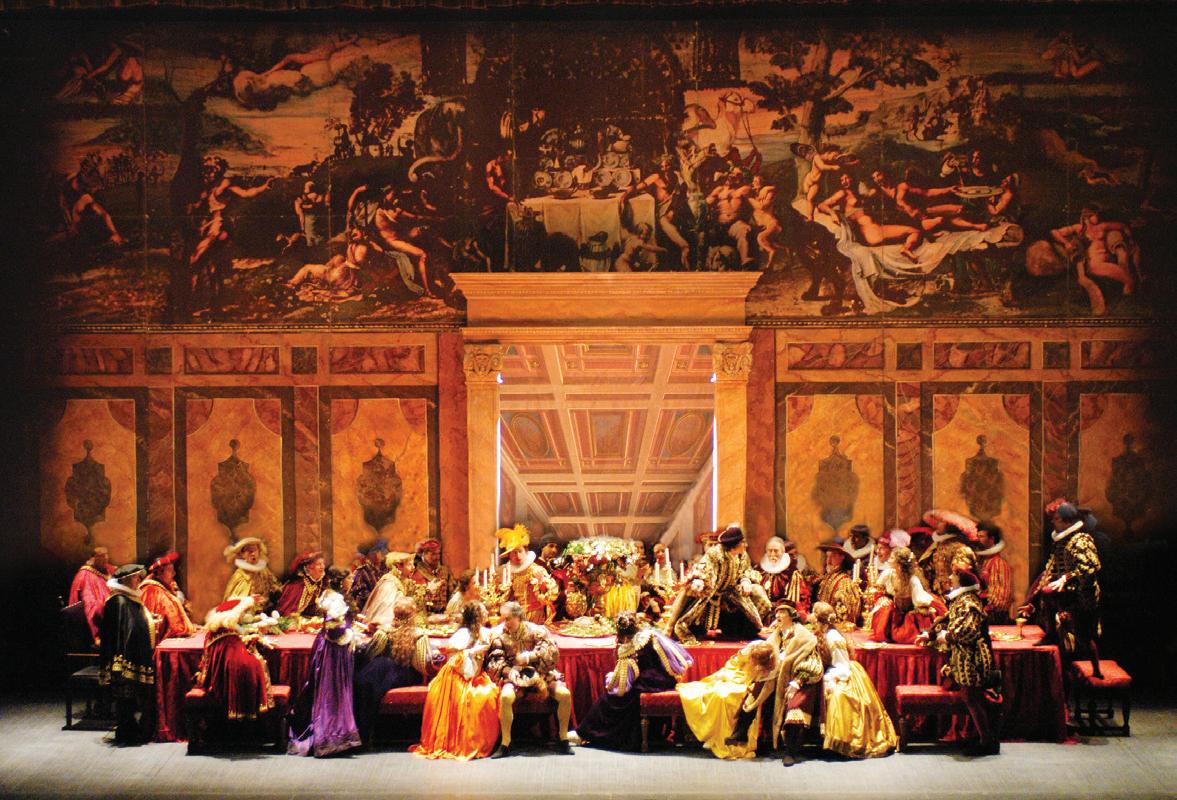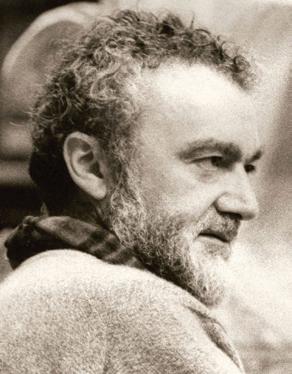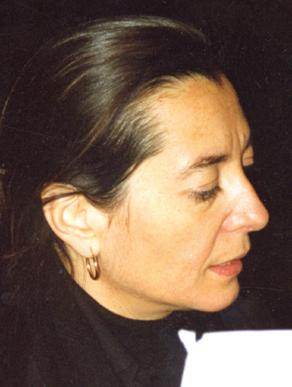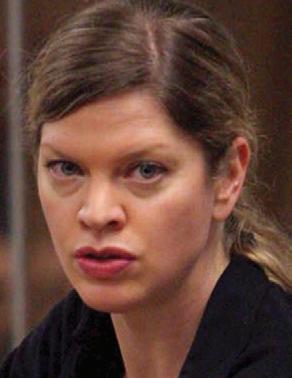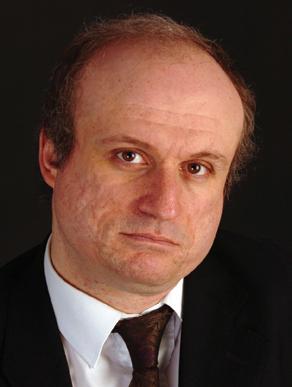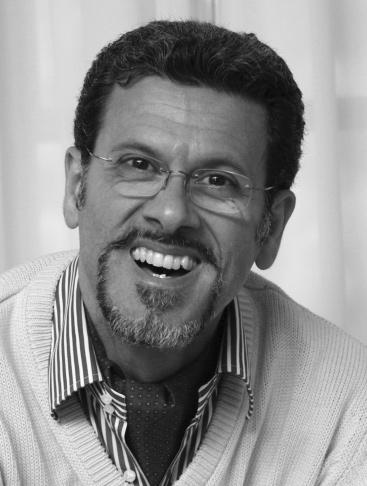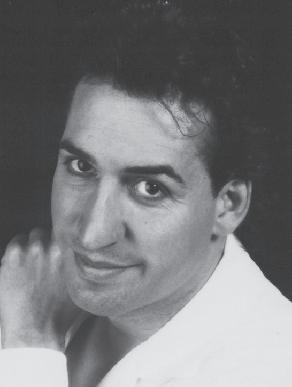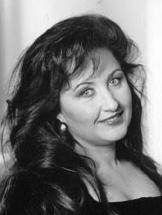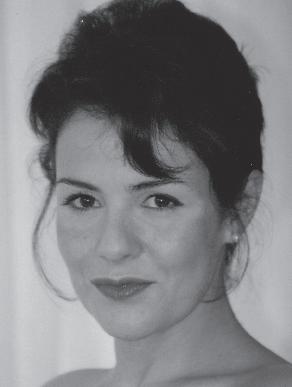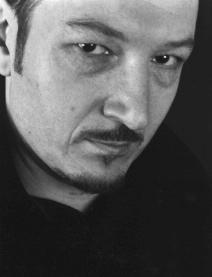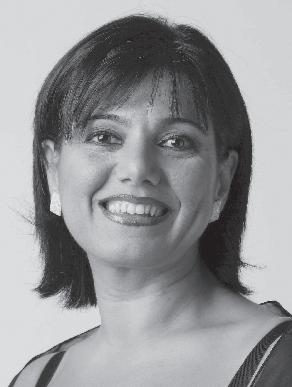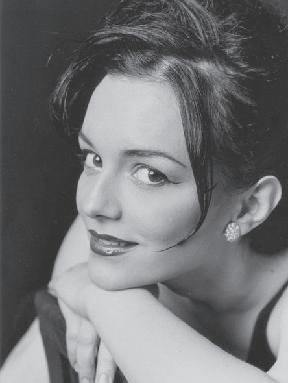hung kai logo.eps
音樂 威爾第
文本
弗蘭西斯科.瑪麗亞.皮亞維
改編雨果原著《國王取樂》
導演 伊莉莎伯塔.布莎
指揮
建構於薩馬里塔尼之意念
凱莉-琳.威爾森
Music Giuseppe Verdi
Libretto Francesco Maria Piave
after Victor Hugo’s Le roi s’amuse
Director Elisabetta Brusa
Based on the ideas of Pier Luigi Samaritani
Conductor Keri-Lynn Wilson
18 演出及製作 Credits
12
故事大綱 Synopsis
19 原創導演的話 Notes from the original Director
22 特稿 跟隨大師的腳步
Feature In the Footsteps of the Master
26 劇團介紹 Theatre Profile
28 樂團及合唱團介紹 Orchestra and Chorus Profiles
32 簡歷 Biographies
38 樂團成員 Orchestra Members
39 合唱團成員 Chorus Members
為了讓大家對這次演出留下美好的印象,請切記在節目開始前關掉手錶、 無綫電話及傳呼機的響鬧裝置。會場內請勿擅自攝影、錄音或錄影,亦不 可飲食和吸煙,多謝合作。
To make this performance a pleasant experience for the artists and other members of the audience, PLEASE switch off your alarm watches, MOBILE PHONES and PAGERS. Eating and drinking, unauthorised photography and audio or video recording are forbidden in the auditorium. Thank you for your co-operation.
所有劇照攝於帕爾馬皇家歌劇院,演員陣容有別於是次香港演出
Pictures in this programme feature the cast of the performance at the Teatro Regio di Parma
7 - 11.3.2008
香港文化中心大劇院
Grand Theatre
Hong Kong Cultural Centre
意大利原文演唱,附中英文字幕 演出長約3小時10分鐘,包括兩節休息
Sung in original Italian with English and Chinese surtitles
Running time: approximately 3 hours and 10 minutes with two intervals
@ Roberto Ricci, Teatro Regio di Parma
音樂 Music
威爾第(Kalmus 古典版)
Giuseppe Verdi (Kalmus Classic Edition)
文本 Libretto
弗蘭西斯科.瑪麗亞.皮亞維 Francesco Maria Piave 改編雨果原著《國王取樂》 after Victor Hugo’s Le roi s’amuse
導演 Director
伊莉莎伯塔.布莎
建構於薩馬里塔尼之意念
Elisabetta Brusa
Based on the ideas of Pier Luigi Samaritani
指揮 Conductor
凱莉-琳.威爾森 Keri-Lynn Wilson
佈景及服裝設計
Sets and Costumes 薩馬里塔尼 Pier Luigi Samaritani
燈光設計 Lights 安德烈亞.波里利 Andrea Borelli
合唱團指導 Chorus Master 馬天奴.法茲安尼 Martino Faggiani
角色 Cast
公爵 The Duke
法爾特.保林 (3月7、9、11日)
法蘭西斯科.德穆羅 (3月8、10日)
利戈力圖(公爵的弄臣)
Valter Borin (Mar 7, 9, 11)
Francesco Demuro (Mar 8, 10)
Rigoletto, the Duke’s jester 路西奧.格羅 (3月7、9、11日)
阿爾拔圖.加沙爾 (3月8、10日)
吉爾達(弄臣的女兒)
Lucio Gallo (Mar 7, 9, 11)
Alberto Gazale (Mar 8, 10)
Gilda, Rigoletto’s daughter 伊蓮娜.莫素克 (3月7、9、11日)
丹妮耶拉.布魯維拉 (3月8、10日)
Elena Mosuc (Mar 7, 9, 11)
Daniela Bruera (Mar 8, 10)
史柏拉夫西勒(刺客) Sparafucile, an assassin 保羅.巴塔格利亞 Paolo Battaglia
瑪德蓮娜(史柏拉夫西勒的妹妹) Maddalena, his sister 羅珊娜.利娜爾迪 Rossana Rinaldi
喬望娜(吉爾達的保母) Giovanna, Gilda’s nurse
卡塔蓮娜.尼歌利克 Katarina Nikolic
蒙特羅伯爵 Count Monterone
菲力普.普林尼利 Filippo Polinelli
馬魯羅 Marullo
尼科羅.艾羅爾迪 Nicolò Ayroldi
馬提奧.波撒(朝臣 ) Matteo Borsa, a courtier 毛羅.布佛利 Mauro Buffoli
西布蘭諾伯爵 Count Ceprano
伊茨奧.馬利亞.提希 Ezio Maria Tisi
西布蘭諾伯爵夫人/侍僮 Countess Ceprano / A page
加布里埃樂.科撒羅 Gabriella Corsaro
宮廷門房 A court usher
羅伯托.斯肯杜拉 Roberto Scandura
暨 with 帕爾馬皇家歌劇院樂團 Teatro Regio di Parma Orchestra
及合唱團 and Chorus
香港特約演員 Hong Kong Supernumeraries
製作人員 Production Team
製作 Production
帕爾馬皇家歌劇院 Teatro Regio di Parma
助理導演 Assistant Director
羅伯托.法魯迪 Roberta Faroldi
音樂統籌總監 Head Music Coach
斯蒂芬奴.拉伯格利亞 Stefano Rabaglia
舞台音樂統籌 Music Coaches on stage
伊蓮娜.利素、西蒙尼.沙維拿 Elena Rizzo and Simone Savina
音樂統籌 Music Coach
馬迪奧.魯碧科尼 Matteo Rubiconi
舞台監督 Stage Manager
包娜.拉薩里 Paola Lazzari
佈景及服裝製作 Sets and Costume Production
帕爾馬皇家歌劇院 Teatro Regio di Parma
鞋 Shoes
龐貝2000 (羅馬) Pompei 2000 (Roma)
髮飾 Wigs
馬里奧.歐德洛 (都靈)
Mario Audello (Torino)
道具 Props
蘭卡蒂 (米蘭科納列多)、 Rancati (Cornaredo MI) and 帕爾馬皇家歌劇院 Teatro Regio di Parma
製作經理 Production Manager
天娜.維亞妮 Tina Viani
技術總監 Technical Director
呂爾吉.西皮里 Luigi Cipelli
佈景監督 Setting Manager
包洛.卡蘭奇尼 Paolo Calanchini
總木匠 Head Carpenter
法蘭西斯科.羅斯 Francesco Rossi
總電力工程師 Head Electrician
安德烈亞.波里利 Andrea Borelli
道具主管 Props Mistress
蒙妮卡.波奇 Monica Bocchi
工作坊監督 Workshop Manager
法斯托.沙賓尼 Fausto Sabini
服裝主管 Wardrobe Mistress
安祖拉.塔德斯科 Angela Tedesco
化妝及髮型 Make-up Artist and Wig Mistress
格拉茲拉.加拉斯 Graziella Galassi
統籌 Co-ordinator
Associazione Teatrale Associazione Teatrale Emilia Romagna Emilia Romagna
中文字幕 Chinese surtitles
黃奇智 Wong Kee-chee
3月9日演出由忠利保險有限公司香港分行支持 9 March performance is supported by Assicurazioni Generali S.p.A., Hong Kong branch
此行支持機構 This tour is supported by
地點: 十六世紀的曼圖亞及附近地區 第一幕
第一場 宮中別殿 曼圖亞公爵在教堂遇見一位陌生美女,驚為天 人;他既想將該女子據為己有,又垂涎西布蘭 諾伯爵夫人美色。事實上公爵跟不少朝臣的妻 子都有染;他們不但綠帽戴上頭,更遭公爵的 駝背弄臣利戈力圖出言侮辱。弄臣還慫恿公爵 剷除這些絆腳石,要麼關起來,要麼殺掉。群 臣中,蒙特羅伯爵因為女兒被公爵玷污而含恨 在心,遂遷怒弄臣;並狠狠詛咒二人。
第二場 街上、弄臣的家 弄臣對蒙特羅伯爵的詛咒耿耿於懷,回家途中 遇到刺客史柏拉夫西勒。史柏拉夫西勒跟弄臣 攀談,希望招來生意。弄臣暗忖兩人有所共 通:他揮劍砍殺,自己出口傷人。弄臣開啟牆 上的暗門,回家見女兒吉爾達。他一直不讓公 爵或城中人看見吉爾達;而吉爾達對父親的 職業也一無所知。由於父親一直不准她公開露 面,除了教堂,她從未踏足過任何地方。
弄臣才走,公爵就到。公爵偷聽到吉爾達跟保 母喬望娜的對話,聽到吉爾達說她在教堂邂逅 一名男子,那男子要是家貧的話,自己會更喜 歡他。她因為瞞着父親,所以心感不安。吉爾 達表白之際,大喜過望的公爵上前對吉爾達表
明心跡。吉爾達起初還有點抗拒,但最終被公 爵打動。吉爾達問公爵姓甚名誰,公爵猶疑地 說自己名叫「古亞爾提耶.馬爾德」。此時,
外面忽然有聲響;吉爾達擔心是父親折返,就 送走公爵。公爵臨走前,兩人還山盟海誓。
第三場 弄臣家中庭院
庭院圍牆外聚集了憤怒的貴族。他們見到弄 臣,又以為吉爾達是弄臣的情人,於是心生一 計:先說服弄臣協助綁架西布蘭諾伯爵夫人, 待他應允後,他們秘密綁架吉爾達。太晚了, 弄臣知道自己上了當,眼前一黑昏倒地上,想 起蒙特羅伯爵的詛咒。
— 中場休息 —
第二幕 公爵的宮殿 貴族告訴公爵,他們把弄臣的情人弄到手;公
爵從這群人口中的描述猜想到被擄的是吉爾 達。既然心上人身處宮中,公爵就急急跑去相 會,口裏嚷着什麼最終吉爾達會知道真相,他 甘願為伊人放棄財富權位,因為這是他第一次 認真地愛云云。
公爵雀躍的表現,起初令眾人莫名奇妙;不過 此時他們轉而戲弄弄臣。弄臣故作冷淡,深怕 吉爾達落入公爵手上。不得要領後弄臣終於說 出自己在尋找親女;眾人大為詫異。吉爾達慌 忙闖入,哀求父親請眾人離開,並流露出得知 父親職業後的羞愧心情。弄臣決定向公爵報 復,吉爾達卻替公爵求情。
—
中場休息 — 第三幕 旅館外的街上
弄臣與吉爾達到達史柏拉夫西勒經營的旅館。
公爵當時在旅館內,因為失去了吉爾達而喝得 醉醺醺,正在勾搭刺客的妹妹瑪德蓮娜。弄臣 讓吉爾達親眼看見公爵的醜態;著名詠嘆調 《善變的女人》響起,刻畫女人不貞、無常的 本性。
弄臣要求史柏拉夫西勒刺殺公爵;經過一番討 價還價,弄臣答應事成之後給他20個金幣作 酬勞。為了錢,史柏拉夫西勒也樂意效勞。弄 臣要求吉爾達女扮男裝先往維羅納,自己稍後 會在那裏跟她會合。暴風雨將至,公爵決定留 宿,史柏拉夫西勒安排他在下層的寢室休息。
儘管公爵風流成性,吉爾達仍然愛他。女扮男 裝的她偷聽到刺客兄妹之間的對話:瑪德蓮娜 哀求哥哥放過公爵。史柏拉夫西勒答應妹妹, 如果半夜以前能找到替死鬼,就饒了公爵一 命。吉爾達決定犧牲自己;她走進旅館便馬上 遭到毒手,傷重倒地,昏迷不醒。
弄臣帶着錢回來,收到一個藏着屍體的麻袋, 欣喜若狂。他準備把綁着石塊的麻袋一起丟進 河的時候,卻聽見公爵唱着哀傷的詠嘆調。弄 臣大惑不解,打開麻袋一看,驚見裏面躺着自 己奄奄一息的親女兒,登時傷心欲絕。吉爾達 回光返照之際,表示自己樂意為愛人犧牲。吉 爾達嚥氣的一刻,弄臣驚叫「那個詛咒!」這 刻,詛咒在主僕二人身上都應驗了。
Place:
Mantua and vicinity in the 16th century
Act I
Scene 1 A Room in the Palace
The Duke has seen an unknown beauty in church and desires her, but he also wishes to seduce the Countess Ceprano, the wife of Count Ceprano. Rigoletto, the Duke’s hunchbacked jester, mocks the husbands of the ladies to whom the Duke is paying attention and advises the Duke to get rid of them by prison or death. The noblemen, especially Count Monterone, whose daughter the Duke has dishonoured, resolve to take vengeance against Rigoletto. Count Monterone curses the Duke and Rigoletto.
Scene 2 On the Street / Rigoletto’s House
Thinking about the curse, the jester approaches his house. Before entering, he is accosted by
the assassin Sparafucile, offering his services. Rigoletto contemplates the similarities between the two of them: Sparafucile uses his sword to fight; Rigoletto uses his tongue and wit. Rigoletto then opens a door in the wall and returns home to his daughter Gilda, who he is hiding from the Duke and the rest of the city. Gilda does not know her father’s occupation and, as he has forbidden her to appear in public, has been nowhere except to church.
Later, when Rigoletto has left the house, the Duke appears and overhears Gilda talking to her nurse Giovanna. Gilda is confessing her guilt for not telling her father about a student she has met at the church: a man she declares, she would love even more if he were poor. Just as she declares her love the Duke enters the house and, overjoyed at what he has heard, convinces Gilda of his own love. When she asks for his name he hesitantly calls himself Gualtier Maldé. Hearing sounds and fearing that her father has returned, Gilda sends the
Duke away, but only after they have quickly repeated vows of love to one and other.
Scene 3 The Courtyard, Rigoletto’s House
The angry noblemen gather outside the walled garden where they meet Rigoletto. Convinced that Gilda is Rigoletto’s mistress they hatch a plan. They convince the jester to help them abduct the Countess Ceprano, and when he agrees they secretly abduct Gilda. Too late, Rigoletto realises he has been duped and, collapsing to the ground, remembers the curse.
— Interval —
Act II The Duke’s Palace
The noblemen inform the Duke that they have captured Rigoletto’s mistress and by their description he recognises it to be Gilda. Since she is in the palace, he rushes off to see her, declaring that at last she will know the truth, and that he will give up his wealth and position for her –– the first person who has inspired him to really love. Perplexed at first by the Duke’s strange excitement, the courtiers now make sport with Rigoletto. He tries to find Gilda by pretending to be uncaring, whilst inwardly fearing that she may fall into the Duke’s hands. Finally, to everyone’s astonishment, he declares that he is seeking his daughter. Gilda then rushes in, begs her father to send the people away, and acknowledges the shame she feels in finding out his profession. Rigoletto demands vengeance against his master, whilst Gilda pleads for him.
— Interval —
Act III The Street outside an Inn
Rigoletto and Gilda arrive outside Sparafucile’s house. Rigoletto shows Gilda the object of her love, who, half-drunk with despair over losing her, is inside Sparafucile’s house attempting to seduce the assassin’s sister Maddalena. It is here that we hear the famous aria La donna è mobile, which laments the infidelity and fickle nature of women.
Rigoletto bargains with the assassin, who is all too eager to murder his guest for money. Rigoletto orders his daughter to put on men’s clothing and go to Verona, where he plans to join her later. He offers the assassin 20 scudi to kill the Duke. As a thunderstorm approaches the Duke decides to stay in the assassin’s house –– so Sparafucile assigns him the ground floor sleeping quarters.
Gilda, who still loves the Duke despite his infidelity, returns to the house dressed as a man. She overhears Maddalena begging the assassin to spare the Duke’s life. The assassin promises that if by midnight another victim can be found in place of the Duke, he will spare the Duke’s life. Gilda resolves to sacrifice herself for the Duke and enters the house. Immediately, she is mortally wounded and collapses.
When Rigoletto arrives with the money he receives a corpse wrapped in a sack and rejoices in triumph. Weighting it with stones he is about to cast the sack into the river when he hears the voice of the Duke singing a reprise of his bitter aria. Bewildered, he opens the sack and, to his despair, discovers his mortally wounded daughter. For a moment she revives and declares she is glad to die for her beloved. As she takes her final breath, Rigoletto exclaims in horror, “The curse!” ––a curse now fulfilled upon both master and servant.
《弄臣》
薩馬里塔尼為1987年製作所繪的彩繪(第一幕第一場)
Samaritani’s sketch of Act I, Scene I from his 1987 production.
文:薩馬里塔尼 近年來我多次獲邀導演 《弄臣》。可是聲樂在劇中 如此重要,總是令我擔心 自己力有不逮;不過我最 終還是接受了挑戰,吸引 力之一是《弄臣》有望在帕 爾馬皇家歌劇院上演。
帕爾馬與威爾第及其創作 靈感關係密切,令人無法視 傳統為討厭的例行公事。相 反,傳統被視為忠於作曲家 的神髓,立意高尚。威爾第是真正的改革者,大膽進取,不懼爭議,如 以一個卑鄙下流的丑角構成整齣歌劇,寫成《弄臣》。《弄臣》表達出極 端的孤單以及解脫無門。我相信,威爾第把注意力和激情都放在這個角色 身上,對其他角色則不太在意。其他角色十分乏味,刻畫粗糙,心理描寫 也只見輪廓不見細節,了無新意,面目模糊;惟有在幾乎不可能的背景中 (宮廷城堡、廢墟、陰暗角落),把這些角色用作可能的立足點,他們才 會顯得充實、鮮明。如果情感色彩豐富一點,角色則會有更高的可信性。
我嘗試另闢蹊徑,把焦點放在「家庭」上:把溫馨家庭看作慈愛的避 難所,一個能讓弄臣小心翼翼地把他的救贖希望撫養成人的地方。雖然 舞台指示未有提及,但這麼一個地方在音樂裏卻很明顯,因此所有情節 (由音樂所表達的情感主宰)都需要鮮明的視覺效果。
服裝有意按十六世紀服飾設計,以免視覺效果太突出,否則《弄臣》會 變成古裝表演,而非一齣以人情冷暖為主的戲劇。我腦海中經常浮現以
下影像:這個討人厭、繃着臉的人物,經常遮遮掩掩,或徒步或踏自行 車,在我熟悉的帕達尼亞山谷濃霧中現身,卻又突然被濃霧吸回去,消 失了⋯⋯只剩下影子——在咕噥,或在吟誦古老的農夫之歌。
排練時,我會聽到關於一眾「吉爾達」、「弄臣」和「公爵」的話,例 如:「吉爾達應該這樣,他們卻那樣」,諸如此類。毫無疑問,正因為 《弄臣》已經上演過無數次,才有這些偏頗的言論和習慣。然而威爾第 的音樂威力驚人,足以頃刻間將這一切一掃而空,而且萬無一失;表達 出歷久常新,永遠真摯的情感。
至於歌手的表現,我一直認為要求一個人放棄慣用的表達方式,而以 另一種表達方式取代,實屬無理。對於舞者來說,舞蹈是慣常的表達模 式,早已根深蒂固。我們可以截停一個正在跳舞的舞者,要求他/她脫 離這種「語言」,放棄那些慣用的訊息,甚至要求跟他/她聊天嗎?
In the Footsteps of the Master
文:羅伯特.圖恩布爾 這個版本的《弄臣》 1987 年初次在意 大利帕爾馬首演;背後卻有個不幸的故 事。1994年,薩馬里塔尼準備重演此劇
期間英年早逝,享年 51 歲。他自知命不 久矣,就把第二幕的背景由原來的曼圖 亞公爵宮中改為曼圖亞巴羅克劇院,藉 此向這個他一生所繫且貢獻良多的藝術 形式致意。
籌備重演期間,由於病情每況愈下,他 已不能親力親為,重任遂落在追隨他多 年的助手伊莉莎伯塔.布莎身上。兩人 幾經商議,布莎終於完成任務。薩馬里 塔尼當時已病入膏肓,言語困難,就在 醫院病床上靠畫圖和簡單閃光信號燈解 釋自己的意念。
by Robert Turnbull
This version of Rigoletto was first staged in Parma, Italy in 1987 and there is a particularly tragic story behind its production. Pier Luigi Samaritani died in 1994, at the young age of 51, just as he was preparing a revival of his original production. Knowing he was approaching death, he decided to change the setting of the Second Act from the Ducal Palace in Mantova, where the opera is set, to a Baroque theatre in the same city. By doing so, Samaritani paid homage to the art form that dominated his life and to which he made such a lasting contribution.
Because Samaritani’s ailing health left him unable to continue his work, it was left to his long-term assistant, Elisabetta Brusa, to take charge of the production,
薩馬里塔尼把第二幕新佈景的草圖留給 布莎後,就給帕爾馬皇家劇院管理層寫 信,授權布莎為這次重演選角,並讓她 加入自己的意念和舞台調度──只是他 已等不及看到成果了。布莎說:「我在演 出中加入一些戲劇元素,同時盡量忠於 首演製作。」又說:「這齣歌劇根據一齣 劇寫成。我認為明白這一點很重要。」
布莎最大的改動是第三幕。史柏拉夫西 勒向弄臣女兒吉爾達下毒手時,所用凶 器正是公爵的佩劍──這是個痛苦的象 徵:因為吉爾達正是公爵的愛人。布莎 也把焦點放在弄臣的帽子。弄臣被蒙特 羅伯爵詛咒之前一直戴着帽子,之後就 把帽子拿在手上,暗示他此後已不再是 「傻瓜」。
布莎繼承了恩師的精神。薩馬里塔尼作 品也有相同特性:細微但威力逼人的戲 劇手法、視覺效果異常清晰的身體動 作,還有讓歌唱家看起來都漂漂亮亮的 功力。事實上,這個製作的服裝不亞於 意大利文藝復興和巴羅克歷史盛會。布
莎說:「薩馬里塔尼喜歡使一切都豐富 奪目,色彩繽紛。觀眾會留意到,尤其 劇院那一場。」
對稱和完整性是薩馬里塔尼的特色, 但燈光也極其重要。薩馬里塔尼多才多 藝,作品所呈現的視覺統一感,在歌劇 裏實屬罕見。他設計《弄臣》時曾仔細 研究過羅馬巴羅克,尤其卓越的壁畫畫 家阿尼巴爾.卡拉契和朱利歐.羅馬 諾。曼圖亞有座美不勝修的文藝復興時 期宮殿「德泰宮」,牆上就遍佈兩人的 作品。薩馬里塔尼臨終前,醫院病床旁 邊就放了一本卡拉契作品畫冊。觀者或 會覺得劇中的明暗對照頗眼熟,那可是 巴羅克畫家卡拉瓦喬及其追隨者畫作裏 常見的。
布莎 20 年前開始擔任薩馬里塔尼的助 手,當時她在威尼斯鳳凰劇院擔任助 理;但直到薩馬里塔尼臨終前四年,布
which she did after lengthy consultation with the ‘maestro’. Samaritani was, by that time, so gravely ill that he had lost his voice and had to explain his vision from his hospital bed with the aid of a series of drawings and a flashlight. Having left Brusa with new sketches of a revised Second Act set, Samaritani penned a letter to the management of the Teatro Regio di Parma authorising Brusa to recast the revival. He also gave Brusa permission to invest the production with her own ideas and blocking – although he did not live long enough to see the results. Brusa remarked: “I have remained as faithful as possible to the original production, while introducing some dramatic elements to the mise-en-scene,” and added, “I feel it’s important to understand that this opera is based on a play.”
Brusa’s most significant changes have been to the Third Act. In her rendition, Sparafucile kills Gilda with the Duke’s sword, rather than his own, giving the act a bitter symbolism –– Gilda had been the Duke’s lover. Brusa also focuses on Rigoletto’s jester hat, which he wears only up to the point that he is cursed by Monterone. From then on he holds the hat in his hand, the implication being that he is no longer a ‘fool’.
Here Brusa follows her mentor in spirit. Samaritani’s work displays similar small dramatic strokes that convey an immediate dramatic effect; movements of great visual clarity, and an ability to make the singers look good. Indeed the costumes in this production suggest nothing less than a pageant of the history of the Italian Renaissance and Baroque. According to Brusa, “Samaritani wanted everything to be rich and a triumph of colour. Audiences will see this, especially in the theatre scene.”
Symmetry and solidity were two of Samaritani’s trademarks but one should state that lighting was crucially important too. The maestro’s versatility produced a unity of vision that is rare in opera. When creating his Rigoletto designs, Samaritani looked
莎與他的工作關係愈見緊密。她說: 「那就是,有人教我如何理解劇場奧 妙。他為人沉默,但很堅定;話也不 多,寧願畫圖溝通。但他表情豐富:只 消看看他的臉就知道他的意思。我們之 間有默契。」
節錄自2007年《閱藝》
羅伯特.圖恩布爾 ,自由撰稿人,定期為 《國際先驅論壇報》和《旁觀者》撰稿,另 為《現代歌劇》專欄作家。
closely at the Roman Baroque, especially the work of the great fresco painters Annibale Carracci and Giulio Romano, whose art covers the walls of Mantova’s stunning Renaissance Palazzo del Te. Interestingly, Samaritani kept a volume of Carracci’s work by his hospital bed before he died. Spectators might also be reminded of the kind of chiaroscuro effects more prevalent in the work of the Baroque painter Caravaggio and his followers.
Brusa’s work with Samaritani began 20 years ago, when she was an assistant at the Teatro La Fenice, but it was only in the last four years of the Master’s life that she began to work with him more closely. “This was someone who gave me the means to understand the mysteries of the theatre”, says Brusa. “He was a quiet person, but very strong. Samaritani used very few words as he preferred to communicate through drawing, but he had very expressive features. It was enough to look at his face to understand what he wanted. We had an understanding.”
This is an excerpt from an article previously published in FestMag 2007.
Robert Turnbull is a freelance journalist who writes regularly for The International Herald Tribune, The Spectator and has a regular column in Opera Now
帕爾馬皇家歌劇院
Teatro Regio di Parma
帕爾馬皇家歌劇院 1829 年落成啟用,是瑪莉亞 . 魯爾吉亞女公爵時期 (1815–1847) 最重要的 遺產,也是當時社會與文 化融和的最佳體現。
劇院的開幕演出是西西里 作曲家貝里尼不太成功的 作品《扎伊拉》。《扎伊拉》並非開幕 歌劇之首選,早在劇院開幕前好一段日 子,院方已接觸羅西尼,可是洽商困難 重重,最終還是沒有成果。不過繼開幕 演出後,劇院第一樂季就已上演羅西尼 的劇作——《摩西與法老》及《塞米拉 密德》,兩齣作品的反應均極佳。
The Teatro Regio di Parma opened in 1829. It is the most important architectual legacy of the Duchess Maria Luigia period (1815–1847), and perfectly represents its ideal of social and cultural fusion.
十九世紀三、四十年代,劇院劇目擴 展到羅西尼、貝里尼和唐尼采第等三位 美聲風格作曲家的作品;到了 1850 年 情況卻急遽轉變。上述三人的崇高地位 確立後不出幾年,威爾第就榮升世上最 重要、最具代表性的意大利作曲家。自 此,劇院與威爾第的一生與作品緊扣在 一起,更於每年的秋天舉辦威爾第節。
二十世紀以來,在帕爾馬皇家歌劇院 演出過的名家包括本尼亞米諾 . 基格 利、瑪莉亞 . 康尼格利亞、馬里奧 . 達 爾 . 摩納科、伊彼 . 斯提格納尼、艾爾 弗列多 . 克勞斯、荷西 . 卡里拉斯、卡 提亞 . 利契亞拉利、瑞那圖 . 布魯森、 萊納 . 卡拜凡斯卡、斯薩爾 . 斯皮、波 利斯 . 克利斯托弗、芭芭拉 . 漢德利克 斯。
The theatre’s opening opera was Vincenzo Bellini’s Zaira, a less than successful work from the Sicilian composer. It was not the first choice––Gioacchino Rossini had been contacted long before the inauguration of the theatre, but a difficult negotiation eventually proved unfruitful. However, after the opening, the first season continued with several of Rossini’s works––the hugely successful Moises and Pharaon and the triumph Semiramide.
In the first decades of the 19th century the Teatro Regio’s repertoire extended to the triad of bel canto composers: Rossini, Bellini and Donizetti. But things changed radically, when Verdi came along in 1850. Only a few years after the consecration of Rossini, Bellini and Donizetti, Verdi became the most important Italian composer in the world. The Teatro Regio has been closely linked to his life and work ever since, and hosts the annual Verdi Festival every autumn.
Over the years the Teatro Regio’s stage has been graced by many famous artists such as Beniamino Gigli, Maria Caniglia, Mario Del Monaco, Ebe Stignani, Alfredo Kraus, José Carreras, Katia Ricciarelli, Renato Bruson, Raina Kabaivanska, Cesare Siepi, Boris Christoff and Barbara Hendricks, amongst others.
帕爾馬皇家歌劇院樂團
Teatro Regio di Parma Orchestra
帕爾馬皇家歌劇院樂團已有數百年歷 史。十八世紀末和十九世紀初是帕爾馬 歷史上最輝煌的年代,是名副其實的音 樂發展──尤其樂團發展──工作坊。十 九及二十世紀這兩百年間,帕爾馬的樂 手成為意大利最優秀樂團的中流砥柱, 同時為所有在帕爾馬皇家歌劇院演出的 歌劇演唱家伴奏。
帕爾馬皇家歌劇院樂團成為皇家歌劇院 的固定樂團後,於2000年首演了華格納 《羅恩格林》和梅耶貝爾《蒂諾拉》, 深受樂迷和樂評人推崇。自2002年起, 在好些世界頂尖指揮家的棒下,樂團演 出了皇家歌劇院所有歌劇、音樂會和威 爾第音樂節的作品。
樂團上一樂季以壓軸音樂會向布列頓致 敬,演出《碧廬冤孽》以及經典之作 《戰爭安魂曲》。
The Teatro Regio di Parma Orchestra’s historical roots go back many centuries. At the end of the 1700s and during the early decades of the 1800s, Parma enjoyed one of the most outstanding periods of its history, becoming a veritable workshop for the development of music, and in particular, for the role of the orchestra. During the 19th and 20th centuries instrumentalists from Parma formed the backbone of the best Italian orchestras, and accompanied all the opera singers that graced the theatre’s stage.
As a permanent ensemble the Teatro Regio Orchestra made its debut in 2000 with Wagner’s Lohengrin and Meyerbeer’s Dinorah, to great critical and public acclaim. Since 2002 it has performed for all the operatic and concert productions staged by Teatro Regio and the Verdi Festival, under the direction of some of the world’s leading conductors.
The Orchestra ended last season with a tribute to Benjamin Britten, performing two of his great works The Turn of the Screw and the monumental War Requiem.
帕爾馬皇家歌劇院合唱團
Teatro Regio di Parma Chorus
威爾第音樂節期間,帕爾馬皇家歌劇院
合唱團在國際瑪莉亞.卡拉斯──威爾 第新聲大賽上首演,由意大利國家廣播 公司電視台廣播;隨後負責演出2001年 威爾第音樂節所有歌劇的合唱部份,包 括威爾第《假面舞會》、《遊唱詩人》、 《弄臣》、《茶花女》、《馬克白》以及 貝里尼《諾瑪》。
合唱團由100位歌手組成,曲目廣泛, 包括歌劇、交響曲以及室樂作品。演出 過的作品計有莫扎特《安魂曲》、威爾 第《四首宗教歌曲》、奧爾夫《布朗尼 之歌》、貝多芬第九交響曲、莫扎特 C 小調彌撒曲、韋華第《榮耀頌》、海頓 《創世記》、巴赫《尊主頌》以及史達 拉汶斯基《伊底帕斯王》。此外,當代作 品也在其曲目中佔有重要地位,包括約 翰.亞當斯《克林格霍芬之死》; VOX 合唱節期間更演出文藝復興時期至當代 多首重要的清唱作品。
The Chorus of the Teatro Regio di Parma made its debut at the Verdi Festival during a RAI TV broadcast of the International Maria Callas –– New Voices for Verdi Competition. Following this, the Chorus performed in all the opera productions at the Verdi Festival 2001, including: Verdi’s Un Ballo in Maschera, Il Trovatore, Rigoletto, La Traviata and Macbeth; and Bellini’s Norma.
The chorus is made up of 100 singers who perform a wide range of music including operatic, symphonic and chamber works. The Chorus’s repertoire includes Mozart’s Requiem; Verdi’s Quattro Pezzi Sacri; Orff’s Carmina Burana ; Beethoven’s Symphony No 9; Mozart’s Mass in C minor; Vivaldi’s Gloria; Haydn’s Creation; Bach’s Magnificat; and Stravinsky’s Oedipus Rex. Contemporary music also plays an important part in the Chorus’s repertoire, including John Adams’s The Death of Klinghoffer. During the Vox, Musica per il coro Festival, the Chorus sung major a cappella works spanning the Renaissance period to contemporary compositions.
皮亞.呂爾吉.薩馬里塔尼
Pier Luigi Samaritani (1943-1994)
原創導演、佈景及服裝設計 Original Director, Set and Costume Designer
皮亞.呂爾吉.薩馬里塔尼生於意大利諾瓦拉,完成學業後入讀米蘭布雷拉美 術學院,繼而負笈巴黎深造;在巴黎認識了著名舞台設計師暨畫家里拉.德諾 比利。受德諾比利啟發,他對劇場產生興趣,並入讀布朗什大街戲劇學院。薩 馬里塔尼年僅 21 歲就獲導演雷蒙.魯洛邀請,為瑪利.貝爾劇院上演的《紅 線》設計佈景,結果一鳴驚人;其後曾出任多位業界名人的助手,包括里拉.德諾比利(斯波萊托 兩個世界藝術節)、法蘭科.茨菲瑞利(巴黎歌劇院、維羅納羅馬歌劇院)以及喬治奧.德克利科(羅 馬歌劇院)。
1967 年,羅馬歌劇院總經理馬西穆.貝吉安克諾邀請他為《曼佛雷德》(舒曼/拜倫) 設計佈景及服裝。是次演出大獲好評,薩馬里塔尼也成為當時得令的設計名家。其後他繼續為意大 利和歐洲各大歌劇院設計佈景及服裝,又多次親赴芝加哥為抒情歌劇院效力; 1987 年他為帕爾馬皇 家歌劇院執導及設計《弄臣》的佈景與服裝。
Pier Luigi Samaritani was born in Novara, Italy, where he completed his classical studies. He later attended the Accademia di Belle Arti di Brera in Milan before going to Paris to study art. In Paris, Samaritani met the celebrated set designer and painter Lila De Nobili who awakened his interest in the theatre. He then enrolled at the Centre Dramatique de la Rue Blanche. At the age of 21 he was invited by director Raymond Rouleau to create sets for Le Fil Rouge at the Theatre de Mary Bell. After this success Samaritani worked as assistant to Lila De Nobili (at the Spoleto Festival of the Two Worlds), Franco Zeffirelli (Opera de Paris; Teatro Romano, Verona), and Giorgio De Chirico (Teatro dell’Opera, Rome). In 1967 Massimo Begianckino, general manager of Rome’s Teatro dell’Opera, invited Samaritani to design sets and costumes for Manfred (Schumann/Byron). The production’s success secured Samaritani’s place as one of the most respected designers of his day. He then went on to design sets and costumes for all the big opera houses in Italy, across Europe and made several trips to the US to work for the Lyric Opera in Chicago. In 1987 he directed and designed the sets and costumes for Rigoletto at the Teatro Regio di Parma.
伊莉莎伯塔.布莎
Elisabetta Brusa
導演 Director
伊莉莎伯塔.布莎於威尼斯佛斯卡力大學畢業,主修藝術;後獲巴黎索邦大學頒 發法國語言及文學文憑,並獲獎學金負笈墨西哥城,修讀演技及導演課程。布莎 曾任多位著名導演的助手,包括皮亞.呂爾吉.匹茲和尚.皮埃爾.龐納勒,還 在皮亞.呂爾吉.薩馬里塔尼晚年擔任他的助理導演。
現為舞台藝術教授的布莎,繼續在意大利國內外導演歌劇和戲劇;過去15年一直 為意大利國家電視台擔任節目編導,製作過大量現場電視節目和歌劇。
Elisabetta Brusa graduated from the Ca’ Foscari University in Venice, majoring in Art. She later received a diploma in French Language and Literature from the Université Paris-Sorbonne and received scholarships to study acting and directing in Mexico City. Brusa has worked as assistant director to many eminent directors including Pier Luigi Pizzi, Jean Pierre Ponnelle and Pier Luigi Samaritani, during the final period of his life.
A professor of theatrical arts, Brusa continues to direct operas and theatrical performances in Italy and overseas. For the past 15 years she has worked as a programme director and writer for RAI (Italian national television) producing many live television events and operas.
凱莉-琳.威爾森
Keri-Lynn Wilson
指揮 Conductor
凱莉-琳.威爾森生於加拿大溫尼伯,學習長笛、鋼琴、小提琴和指揮,獲紐約 茱莉亞音樂學院長笛演奏碩士學位。 23 歲時首度與渥太華國家藝術中心樂團演 出;1994至1998年間出任檀格塢音樂中心指揮助理及達拉斯交響樂團副指揮。
過去幾個樂季,她曾指揮的樂團包括蒙特利爾交響樂團、多倫多交響樂團和洛杉 磯愛樂樂團;指揮過的歌劇包括《蝴蝶夫人》、《波希米亞生涯》和《杜蘭朵》。她也曾導演意大利托 斯卡尼尼基金會樂團之《弄臣》。
Born in Winnipeg, Canada, Keri-Lynn Wilson studied flute, piano, violin and conducting, and holds a Master’s degree in flute performance from The Juilliard School in New York. She made her conducting debut with the National Arts Center Orchestra of Ottawa at the age of 23 and has served as a conducting fellow at the Tanglewood Music Center and associate conductor of the Dallas Symphony Orchestra between 1994 and 1998.
In recent seasons Wilson has conducted the Montreal Symphony Orchestra, the Toronto Symphony Orchestra and the Los Angeles Philharmonic in productions of Madama Butterfly, La Bohème and Turandot She directed Rigoletto with the Fondazione Arturo Toscanini Orchestra, in Italy.
馬天奴.法茲安尼
Martino Faggiani
合唱團指導
Chorus Master
馬天奴.法茲安尼生於羅馬,在當地接受音樂教育,師隨法蘭科.米多利(鋼 琴)、拿札利奧.貝蘭迪(作曲)和保拉.貝蘭納迪(古鍵琴); 1980 年自聖西西 里音樂學院畢業後開始擔任指揮,1999至2005年間任職著名的羅馬聖西西里國 立音樂學院合唱團,擔任首席合唱指導諾伯特.巴拉茨的助手,參與合唱團所有 演出。法茲安尼曾合作過的名指揮包括喬塞比.西諾波利、法比奧.比昂迪和利 納爾多.艾歷山德烈尼。
法茲安尼近期的重要演出包括《伊底帕斯王》﹝吉安呂基.吉爾麥提指揮﹞、《阿依達》﹝那不勒斯聖 卡羅歌劇院﹞、亨策《無窮新讚》和《勝利的猶滴》﹝意大利巡迴演出,艾歷山德羅.德馬其指揮﹞。
他2000年起出任威爾第音樂節合唱指導;另於2001/02樂季也曾出任帕爾馬皇家歌劇院合唱指導。
Martino Faggiani was born in Rome where he received his musical training studying under Franco Medori (piano), Nazario Bellandi (composition) and Paola Beranardi (harpsichord). After graduating from the Santa Cecilia Conservatory in 1980, he began his professional career as a conductor. From 1999 to 2005 he assisted Norbert Balatsch, the principal chorus master of the renowned Coro dell’Accademia Nazionale di Santa Cecilia in Rome, working with him on all the company’s musical productions. Faggiani has also worked with many esteemed conductors such as Giuseppe Sinopoli, Fabio Biondi and Rinaldo Alessandrini.
Recent highlights for Faggiani include Oedipus Rex conducted by Gianluigi Gelmetti; Aida at the Teatro di San Carlo, Napoli; Henze’s Novae de infinito laudes; as well as an Italian tour of Juditha triumphans conducted by Alessandro de Marchi. Since 2000 Faggiani has been Chorus Master for the Verdi Festival and for the 2001-02 season, he was also the chorus master for the Teatro Regio di Parma.
法爾特.保林 公爵 (3月7、9及11日)
Valter Borin The Duke (Mar 7, 9 and 11)
男高音 Tenor
法爾特.保林生於米蘭,先後於米蘭隨維多利奧.特蘭諾瓦學習歌劇演唱,師 承著名男中音艾爾多.普洛提和西班牙男高音艾爾弗多.克勞斯。1994及1998 年,他分別在米蘭威爾第音樂學院鋼琴系及作曲系畢業。
1993 年,保林首個要角演出為伊布拉印(《阿爾卡斯諾與尼科麗塔》);1995年 在倫敦荷蘭公園劇院飾演公爵(《弄臣》),其他角色計有魯基羅(《燕子》)、魯道夫 (《波希米亞生涯》)、麥杜夫(《馬克白》)、卡西歐(《奧塞羅》)以及艾爾弗列多(《茶花女》)。
保林於1996年利嘉諾國際大賽中獲季軍,1998年又在費魯齊奧.塔格利亞維尼國際歌唱大賽中奪魁。
Valter Borin was born in Milan. He studied opera singing in Milan under the guidance of Vittorio Terranova and was taught by the great baritone Aldo Protti and the Spanish tenor Alfredo Kraus. He graduated in Piano (1994) and Composition (1998) from the Giuseppe Verdi Conservatory in Milan.
Borin performed his first major role – Ibrahim in Alcassino e Nicoletta in 1993, followed by the Duke in Rigoletto at the Holland Park Theatre in London in 1995. Other roles include Ruggero in La Rondine, Rodolfo in La Bohème, Macduff in Macbeth, Cassio in Otello and Alfredo in La Traviata
An internationally acclaimed performer, Borin won Third Prize at the Third International Competition of Lignano in 1996, and First Prize in the International Ferruccio Tagliavini Singing Competition in 1998.
法蘭西斯科.德穆羅 公爵 (3月8及10日)
Francesco Demuro The Duke (Mar 8 and 10)
法蘭西斯科.德穆羅1978年生於意大利薩丁尼亞。他
男高音 Tenor
2003至2004年間德穆羅入讀薩丁尼亞沙薩里音樂學院,後以私人學生身份加入 卡利亞里音樂學院,隨女高音伊莉莎伯塔.斯康盧學習至今。
德穆羅將參演薩撒里和帕爾馬歌劇院之《露易莎.米勒》、都靈歌劇院之《弄臣》和米蘭史卡拉歌劇院 的《波希米亞生涯》。
Francesco Demuro was born in Sardinia, Italy in 1978. At the age of 10 he made his first stage performance and at 14 began to make occasional appearances with professional vocalists.
In 2003 and 2004 he studied at the Conservatory of Sassari in Sardinia, and afterwards joined the Conservatory of Cagliari, also in Sardinia, as a private student. Here he took singing lessons with the soprano Elisabetta Scanu, with whom he still studies.
Future engagements for Demuro include Luisa Miller in Sassari and Parma; Rigoletto in Turin; and La Bohème at the La Scala in Milan.
路西奧.格羅 弄臣 (3月7、9及11日)
Lucio Gallo Rigoletto (Mar 7, 9 and 11)
男中音 Baritone
路西奧.格羅生於意大利南部,於都靈威爾第音樂學院畢業,師承伊莉奧.巴塔 格利亞。他定期在世界各地頂尖歌劇院及音樂廳演出,足跡遍踏紐約、三藩市、 維也納、倫敦、柏林、漢堡、北京、東京、特拉維夫以及意大利各大歌劇院。
格羅合作過的指揮家包括海廷克、尼科勞斯.赫農科特、祖賓.梅達、穆狄;飾 演過的角色包括莫扎特歌劇角色如古列爾摩、費加羅、魯納伯爵、唐.喬望尼、 利波里奧;羅西尼歌劇角色如費加羅、丹廸尼、席尼上校、唐.艾爾法羅、巴東尼;威爾第歌劇角色 保羅.艾爾比安尼、西蒙尼、馬克白、波薩、雅戈、霍德。
Born in Southern Italy, Lucio Gallo graduated from the Giuseppe Verdi Conservatory in Turin, having studied with Elio Battaglia. He is a regular guest at many of the world’s leading opera theatres and concert halls and has performed in New York, San Francisco, Vienna, London, Berlin, Hamburg, Beijing, Tokyo, Tel Aviv and in all the major Italian houses.
Gallo has collaborated with conductors such as Bernard Haitink, Nikolaus Harnoncourt, Zubin Mehta, Riccardo Muti and performed many principal roles including Mozart’s Guglielmo, Figaro, Count di Luna, Don Giovanni and Leporello; Rossini’s Figaro, Dandini, Lord Sidney, Don Alvaro and Batone; and Verdi’s Paolo Albiani, Simone, Macbeth, Posa, Jago and Ford.
阿爾拔圖.加沙爾 弄臣 (3月8及10日)
Alberto Gazale Rigoletto (Mar 8 and 10)
男中音 Baritone
阿爾拔圖.加沙爾在意大利撒丁島出生,曾於維羅納達爾.阿巴科音樂學院、曼 圖亞音樂學院、帕爾馬及布薩圖的維迪安那學院修讀音樂。加沙爾師從雷娜塔. 斯科托及基阿尼.萊蒙迪,並隨男高音卡洛.貝爾貢齊研習威爾第的作品。加沙 爾首次歌劇演出,是1998年帕爾馬皇家歌劇院製作之《假面舞會》。
加沙爾合作過的指揮家包括穆狄、柯蘭,亦曾與導演茨菲瑞利合作。他定期於意大利著名劇院演出、
又經常巡演歐美及日本等地,演唱曲目眾多,包括威爾第《茶花女》、《阿依達》、《奧塞羅》、《馬克 白》、《遊吟詩人》及《唐.卡洛斯》,以及普契尼、羅西尼、莫扎特和馬斯卡尼的作品。
Alberto Gazale was born in Sardinia and studied music at the Conservatorio Statale di Musica Evaristo Felice Dall’Abaco in Verona, the Accademia Lirica in Mantova and the Accademia Verdiana in both Parma and Busseto. He perfected his voice with Renata Scotto and Gianni Raimondi and the tenor Carlo Bergonzi, with whom he focussed on the Verdi repertoire. He made his operatic debut in Un ballo in maschera in Parma in 1998.
Gazale has collaborated with conductors such as Riccardo Muti, Daniel Oren and the director Franco Zeffirelli. He regularly performs in major Italian theatres, as well as opera houses in Europe, the US and Japan. His extensive repertoire includes Verdi’s La Traviata, Aida, Otello, Macbeth, Il Trovatore and Don Carlos, as well as works by Puccini, Rossini, Mozart and Mascagni.
依蓮娜.莫素克 吉爾達 (3月7、9及11日)
Elena Mosuc Gilda (Mar 7, 9 and 11)
女高音 Soprano
依蓮娜.莫素克生於羅馬尼亞,後入讀雅西的喬治.艾涅斯庫音樂學院,莫素克 曾贏得德國電視台主辦的國際音樂大賽冠軍, 1991 年再在蒙地卡羅聲樂大師比 賽奪魁。
莫素克踏遍歐洲各大歌劇院舞台,包括慕尼黑、德累斯頓、漢堡、柏林、維也 納、盧森堡、巴黎和阿姆斯特丹,亦曾在中國和日本演出。
本樂季她將首次在史卡拉歌劇院登台,參演《茶花女》;另外亦獲邀在蘇黎世歌劇院飾演柳兒、露西亞 和咪咪,還有在維也納歌劇院飾演茶花女。
Elena Mosuc was born in Romania and educated at the George Enescu Conservatory in Iasi. She won the International Music Competition organised by the German Television Station ARD and in 1991 won the Monte-Carlo Voice Masters Competition.
Mosuc has performed in all the important opera houses of Europe including Munich, Dresden, Hamburg, Berlin, Vienna, Luxemburg, Paris, Amsterdam as well as those in Japan and China.
This season she will make her debut at La Scala in La Traviata; and has been invited to sing Liù, Lucia and Mimì in Zurich, as well Violetta Valéry at the Vienna State Opera.
丹妮耶拉.布魯維拉 吉爾達 (3月8及10日)
Daniela Bruera Gilda (Mar 8 and 10)
女高音 Soprano
丹妮耶拉.布魯維拉起初在意大利撒丁島卡利亞里修讀音樂,繼而入讀威爾第 音樂學院專攻聲樂; 1990 年贏得意大利歌劇及音樂會協會大賽冠軍後獲演出機 會,參與韋華第《朱廸塔的勝利》演出。
布魯維拉是國際知名的歌唱家,飾演過所有著名女角,包括瑪莉亞(《夢斷城 西》)、娜尼塔(《法爾斯塔夫》)和維奧利塔(《茶花女》)。
Daniela Bruera first studied music in Cagliari, Sardinia and went on to specialise in singing at the Giuseppe Verdi Conservatory. In 1990 she won the As. Li. Co. Competition, giving her the chance to debut in Antonio Vivaldi’s Juditha Triumphans.
An internationally acclaimed singer, Bruera has performed all the famous female roles, including Maria in West Side Story, Nannetta in Falstaff and Violetta in La Traviata
保羅.巴塔格利亞 史柏拉夫西勒
Paolo Battaglia Sparafucile
男低音 Bass
保羅.巴塔格利亞生於意大利,自幼學習單簧管和薩克斯管,後來專攻聲樂,師 承瑪莉莎.波諾米利。
巴塔格利亞的曲目包括蒙特威爾第和馬倫齊奧的《牧歌》、德伏扎克 D 大調彌撒 曲、莫扎特《加冕彌撒曲》、羅西尼《聖母悼歌》、卡利西密《耶弗他》、舒伯 特G大調彌撒曲以及當代作曲家作品。
Born in Brescia, Italy, Paolo Battaglia began to study clarinet and saxophone at a very young age and later devoted himself to vocal studies under Marisa Bonomelli.
Battaglia’s concert repertoire includes Monteverdi’s and Marenzio’s Madrigali, Dvorák’s Mass in D major; Mozart’s Krönungsmesse, Rossini’s Stabat Mater, Carissimi’s Jephte, Schubert’s Mass in G major and works of contemporary composers’.
Rossana Rinaldi Maddalena
羅珊娜.利娜爾迪於薩勒諾音樂學院畢業;再師從保羅.華盛頓深造,並參與瑞 娜塔.史柯圖、保羅.蒙塔索羅以及米亞塔.塞吉勒大師班。
2001 年,她與杜鳴高、卡里拉斯、荷西.庫拉以及多位藝術家攜手,在威爾第 逝世100 周年紀念音樂會上演出;之後利娜爾迪也在史卡拉歌劇院飾演伊米利亞 (《奧塞羅》,穆狄指揮),並定期在意大利國內外演出。
Rossana Rinaldi completed her musical studies at the Salerno Music Conservatory. She went on to study with Paolo Washington and attended masterclasses with Renata Scotto, Paolo Montarsolo and Mietta Sieghele.
In 2001 she joined Placido Domingo, José Carreras, José Cura, and many others in the commemoration of the 100th anniversary of Verdi’s death, and went on to sing Emilia in Otello for La Scala, under Riccardo Muti. Rinaldi is internationally acclaimed, performing regularly both in Italy and abroad.
卡塔蓮娜.尼歌利克 喬望娜
Katarina Nikolic Giovanna 女中音 Mezzo-soprano
卡塔蓮娜.尼歌利克生於塞爾維亞,在帕爾馬音樂學院和米蘭音樂學院學習聲 樂,飾演過的角色包括羅拉(《鄉間騎士》)、梅多拉(《海盜》)、菲妮娜 (《那 布果》)、西布蘭諾伯爵夫人(《弄臣》)和瑪特(《浮士德》),足跡遍踏意大利 知名歌劇院,包括薩勒諾威爾第歌劇院、帕爾馬威爾第音樂節及巴薩諾歌劇節。
Katarina Nikolic was born in Serbia, and studied singing at the Conservatories of Parma and Milan. She has performed Lola in Cavalleria Rusticana, Medora in Il Corsaro, Fenena in Nabucco, Countess Ceprano in Rigoletto and Marthe in Faust. She has performed on many prestigious Italian operatic stages including the Teatro Verdi of Salerno, the Verdi Festival in Parma and the Bassano Opera Festival.
場刊中譯:鄭曉彤
帕爾馬皇家歌劇院樂團


